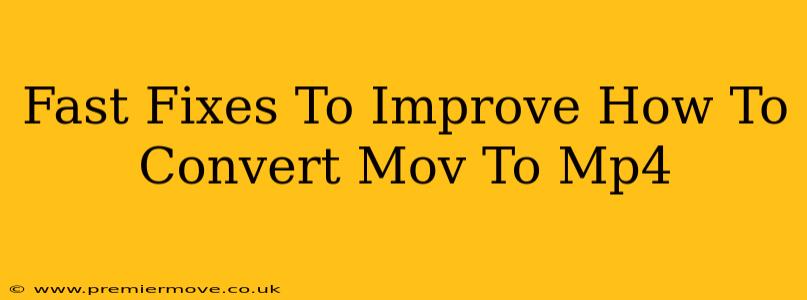Converting MOV files to MP4 is a common task, but sometimes the process can be frustrating. Whether you're dealing with slow conversion speeds, poor quality output, or just plain incompatibility, this post offers quick solutions to optimize your MOV to MP4 workflow.
Understanding the MOV and MP4 Formats
Before diving into the fixes, let's quickly understand why conversion is sometimes necessary. MOV (QuickTime Movie) is a container format developed by Apple, while MP4 (MPEG-4 Part 14) is a more widely compatible container format. While many devices play MOV files, MP4 offers broader compatibility across platforms and devices, making it the preferred choice for sharing and playback.
Common Conversion Problems and Their Solutions
Here are some common issues you might encounter when converting MOV to MP4 and how to address them:
1. Slow Conversion Speed
Problem: Your MOV to MP4 conversion takes forever!
Solutions:
- Upgrade your hardware: A faster processor and more RAM will significantly speed up the conversion process.
- Use a powerful converter: Some converters are optimized for speed and efficiency. Experiment with different software to find one that suits your needs. Consider software utilizing hardware acceleration if available.
- Reduce file size: If your MOV file is extremely large, try compressing it before conversion. This will reduce the processing time. You can use video editing software to reduce the resolution or bitrate without significantly impacting visual quality.
- Convert in batches: If you have multiple files to convert, consider using a converter that allows batch processing. This will usually save time compared to converting files one-by-one.
2. Poor Video or Audio Quality
Problem: After conversion, the quality of your video or audio is noticeably degraded.
Solutions:
- Choose a higher bitrate: A higher bitrate generally results in better quality, but also a larger file size. Find a balance between quality and file size that suits your needs. Experiment with different bitrate settings within your chosen conversion software.
- Use a lossless codec: While lossless codecs maintain the original quality, they result in much larger file sizes. This is often not practical for sharing or storage. Lossy compression, while reducing quality slightly, offers much smaller file sizes, making it a much more common choice.
- Select the appropriate preset: Many converters offer presets optimized for different devices and uses (e.g., YouTube upload, mobile viewing). Selecting the correct preset can often dramatically improve the output quality.
3. Incompatibility Issues
Problem: The converted MP4 file doesn't play on your target device or software.
Solutions:
- Check the codec compatibility: Ensure your chosen converter uses codecs compatible with your target device or software. Different codecs support different levels of compression and features. Some are very widely compatible, while others are more specialized.
- Use a reliable converter: Some converters are better at handling different codecs and ensuring compatibility than others. Research and choose a converter with a reputation for reliably producing compatible MP4 files. Reviews from other users can be invaluable here.
Choosing the Right Converter: Key Considerations
When selecting a MOV to MP4 converter, consider the following:
- Speed: How fast does it convert files?
- Quality: Does it preserve the original quality?
- Features: Does it offer batch processing, preset options, and other helpful features?
- Compatibility: Is it compatible with your operating system and target devices?
- Ease of use: Is the interface intuitive and easy to navigate?
By understanding these common issues and their solutions, you can significantly improve your MOV to MP4 conversion process, resulting in faster conversions and higher-quality output files. Remember to experiment with different settings and converters to find the optimal solution for your specific needs.

